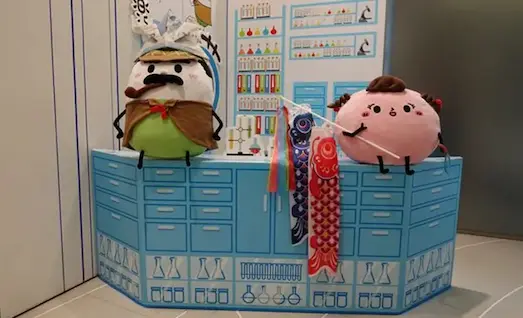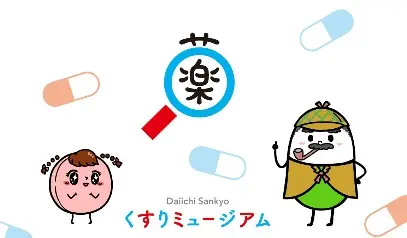With the aim of deepening the understanding of our business, drug discovery activities, as well as widely spreading knowledge about the importance of medicine as a good corporate citizen, Daiichi Sankyo engages in dialogue with local communities, which is one of our most important stakeholders.
Operation of the Daiichi Sankyo Kusuri Museum
The Daiichi Sankyo Kusuri Museum(The Daiichi Sankyo Museum of Medicine. “Kusuri” means “medicine” in Japanese.) was opened in 2012 for the purpose of deepening the knowledge of visitors to the Museum about the importance of medicine and drug discovery activities while playing and enjoying, and for the purpose of contributing to the revitalization of the Nihonbashi area where our head office is located. A facility that offers information to a wide range of stakeholders, the Museum is in its 10th year anniversary, with the cumulative total number of visitors exceeding 140,000.*1
The Museum exhibits include easy-to-understand explanations of the activities of pharmaceutical companies and the proper use of medicine. Located in the Nihonbashi district of Tokyo, which has historically been associated with medicine in Japan, the facility welcomes visitors of all ages, and is even used for company training, school trips, and industry research by job hunters, as well as by parents aiming to foster a sense of curiosity in their children.
To prevent the spread of COVID-19, the annual spring and summer limited-time events are suspended, and the Museum is currently only open for reservations, with a maximum of three slots per day, two groups per slot, and of 10 people per group. *2
In addition, we have posted some of the videos shown at the Museum on the official website of the Daiichi Sankyo Kusuri Museum, so as to allow as many people as possible to see exhibits in the Museum, even if they are unable to do so in person due to COVID-19-induced restrictions on travel or entrance.
For the enjoyment of all visitors, “Kusurina” and “James,” the characters of the Daiichi Sankyo Kusuri Museum, are waiting for you to visit the Museum in their seasonal outfits.

We will continue to develop new ideas and make improvements to the Museum so that visitors can learn even more about the importance of medicine while having fun despite the COVID-19 pandemic.
- *1 As of April 2022
- *2 As of June 2022. Please check the official website of the Kusuri Museum before visiting.

“Kusurina” and “James” at the Kusuri Museum
Daiichi Sankyo Kusuri Museum
Daiichi Sankyo’s Efforts for Promoting Correct Understanding of Diseases and Enlightening Activities
Daiichi Sankyo Co., Ltd. is striving to contribute to the enrichment of quality of life of the local community with improved understanding of every employee about diseases and through disease enlightening activities.
Epilepsy, in particular, is often unnoticed and takes a long time to be diagnosed in the absence of commonly known "convulsions," and there are many cases in which patients and their families, as well as those around them at school and work, have concerns or worries in their daily lives. We are engaged in activities aimed at the correct understanding of epilepsy and the promotion of better treatments, such as providing healthcare professionals with tools for early detection (poster for display in hospitals, check sheets, etc.).
Migraine is another disease that many patients suffer from alone, as it is difficult for those around them to understand their condition. Migraine is a typical disorder that interferes with daily and social activities and is reported to affect 8.4% of Japanese adults. In addition to headaches, patients with migraine may feel uncomfortable with light, sounds, and odors. They may also feel nausea and vomiting and require rest, resulting in difficulty commuting to school or work. Daiichi Sankyo has launched the website “Migraine.info” for the general public to gain a better understanding of migraines and to help patients figure out ways to live with the disease.
In addition, osteoporosis patients are expected to further increase in Japan which has become a super aging society. On the other hand, the treatment rate for osteoporosis patients in Japan is relatively low compared to the level of other developed countries, and patients with a bone fracture of the proximal part of the femur, which is a cause of becoming bedridden, continue to increase. In order to deepen the understanding of patients and their families on osteoporosis so that patients can live without becoming bedridden, we have opened a website for the general public, “Bonefine.com (Are you confident about your bones?)” as part of the disease enlightenment activity under the catch phrase of “Check up on your bone density!”
Our website contains information on the prevention and early detection of a wide range of diseases, such as epilepsy, atrial fibrillation, and reflux esophagitis, in addition to dementia and osteoporosis.